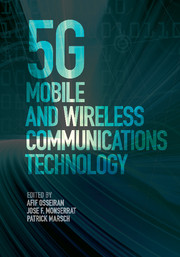Book contents
- Frontmatter
- Dedication
- Contents
- List of contributors
- Foreword
- Acknowledgments
- Acronyms
- 1 Introduction
- 2 5G use cases and system concept
- 3 The 5G architecture
- 4 Machine-type communications
- 5 Device-to-device (D2D) communications
- 6 Millimeter wave communications
- 7 The 5G radio-access technologies
- 8 Massive multiple-input multiple-output (MIMO) systems
- 9 Coordinated multi-point transmission in 5G
- 10 Relaying and wireless network coding
- 11 Interference management, mobility management, and dynamic reconfiguration
- 12 Spectrum
- 13 The 5G wireless propagation channel models
- 14 Simulation methodology
- Index
- References
11 - Interference management, mobility management, and dynamic reconfiguration
Published online by Cambridge University Press: 05 June 2016
- Frontmatter
- Dedication
- Contents
- List of contributors
- Foreword
- Acknowledgments
- Acronyms
- 1 Introduction
- 2 5G use cases and system concept
- 3 The 5G architecture
- 4 Machine-type communications
- 5 Device-to-device (D2D) communications
- 6 Millimeter wave communications
- 7 The 5G radio-access technologies
- 8 Massive multiple-input multiple-output (MIMO) systems
- 9 Coordinated multi-point transmission in 5G
- 10 Relaying and wireless network coding
- 11 Interference management, mobility management, and dynamic reconfiguration
- 12 Spectrum
- 13 The 5G wireless propagation channel models
- 14 Simulation methodology
- Index
- References
Summary
This chapter covers network-level solutions aiming at enhancing end-user experience and bringing down the Operational Expenditures (OPEX) of the 5G deployments.
After analyzing contemporary trends and predictions for 5G, it becomes evident that there are certain aspects of 5G deployments that have to be taken into consideration when designing future network-level solutions. These aspects are predominantly related to the network densification and increasing heterogeneity. While network densification will result in much smaller distances between the Base Stations (BSs) [1], the heterogeneity of 5G will manifest itself in multiple dimensions e.g. cell types or operating frequency. [2]. This complicated heterogeneous environment, apart from dimensioning and planning problems, brings also opportunities for an efficient mapping of users or services to optimal (from the overall system perspective) access technologies or BS types. Aspects related to efficient signaling exchange in this heterogeneous environment (also in scenarios with control/user plane decoupling) are related to a Lean System Control Plane design (cf. Chapter 2).
Based on the previously mentioned factors, it can be easily inferred that one of the most desired 5G features is broadly understood flexibility. The flexibility can be achieved in different ways, starting from a flexible allocation of radio resources in Time Division Duplexing (TDD) mode according to instantaneous traffic conditions, through an efficient exploitation of different Radio Access Technologies (RATs) or network layers, and finally as a freedom to dynamically reconfigure the network using BSs that are automatically configured and self-backhauled. Besides, the kind and extent of Moving Networks (MNs) expected to be introduced in 5G can be perceived as a dynamic reconfiguration enabler and an important part of the Dynamic Radio Access Network (RAN) described in Chapter 2.
The performance of the 5G system can be further enhanced by exploiting context information understood as “(…) any information that can be used to characterize the situation of an entity. An entity is a person, place, or object that is considered relevant to the interaction between a user and an application, including the user and application themselves” [3]. Today, there are already many application domains and envisioned use cases where devices (such as sensors) or services (such as cloud services) communicate for unconscious support of people in their everyday life tasks.
- Type
- Chapter
- Information
- 5G Mobile and Wireless Communications Technology , pp. 303 - 335Publisher: Cambridge University PressPrint publication year: 2016

